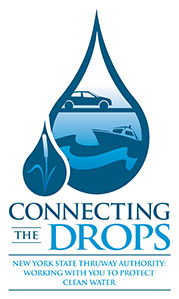Water Quality
Connecting the Drops Factsheets
 Connecting the Drops ~ The New York State Thruway Authority:
Connecting the Drops ~ The New York State Thruway Authority:
Working with You to Protect Clean Water
The Connecting the Drops Campaign —
Connecting the Drops is a public outreach campaign of the New York State Thruway (NYSTA). The goal of this outreach is to remind New Yorkers that water connects us all, and that what is dropped in the environment can reach water bodies and put aquatic life, recreation and even drinking water at risk. The Connect the Drops effort includes educating Authority employees, as well as all the motorists and boaters that use the Thruway and NYS waterways.
Why? —
Everyone depends on clean water, and therefore has a responsibility to keep it clean. To protect clean water, an understanding of how pollution can reach the rivers, lakes, and streams within our watershed is needed. The public also needs to know what they can do to prevent pollution, particularly non-point source pollution. The Authority is working to prevent pollution from all roads and facilities, and an important part of this effort is education. If the New York public understands the importance of working together to prevent pollution from reaching waterways, this effort can be successful.
Q. What is a watershed?
A. A watershed is an area of land where all the water that falls in it and drains off it goes to the same place. For example, all water in the Hudson River watershed would eventually flow into the Hudson River. The entire Hudson River watershed is 13,400 square miles.
Q. What is the water cycle?
A. The water cycle is the system by which water moves through the environment. Water is collected and redistributed through several processes: precipitation (rain, snow); infiltration and percolation into soil; transpiration (moved through roots, plants, and into atmosphere); evaporation; and condensation.
Q. What is the difference between point source and non-point source pollution?
A. Point-source pollution generally comes from the wastewater discharged from the pipes of industrial facilities and municipal sewage treatment plants into rivers, streams, lakes, and the ocean. Non-point source pollution enters the environment from a widespread area that is not clearly defined. Rather than coming from the end of a pipe, non-point source pollution comes from storm runoff (rain, snow) from parking lots, city streets, farmland, even your own yard. It can contain oils, spilled chemicals, pesticides, fertilizers, sewage, or litter.
Q. How does stormwater get contaminated?
A. When water flows through a watershed it can carry any pollution that it picks up along the way. This means that pollution spilled or dropped in a parking lot or on the ground can reach a river or stream some distance away.
Q. How does the NYSTA work to prevent stormwater pollution?
A. A federal regulation requires permits for stormwater discharges from Municipal Separate Storm Sewer Systems (MS4s), which includes the New York State Thruway Authority (NYSTA). Under this permit, NYSTA is implementing a five-year, system-wide stormwater management program that includes public education and outreach; public participation; detection and elimination of all illicit discharges; construction site runoff control; post-construction runoff control; and pollution prevention. NYSTA is working hard to help protect clean water.